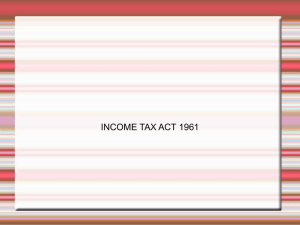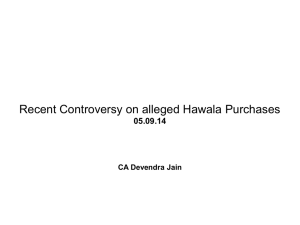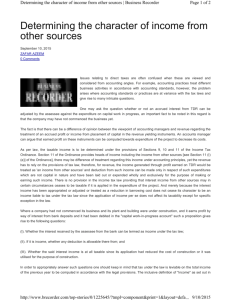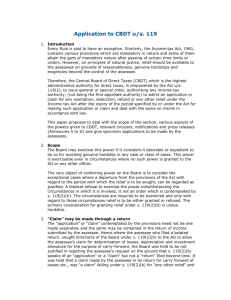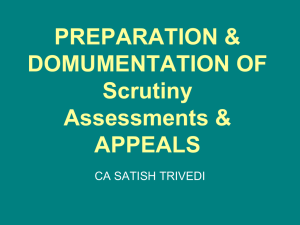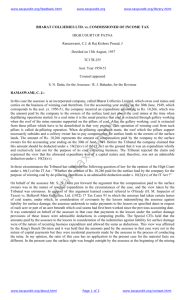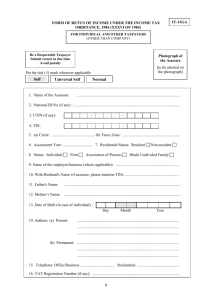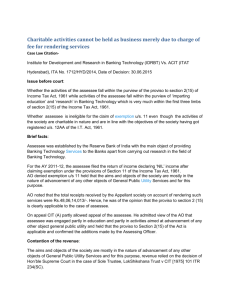order - itat
advertisement
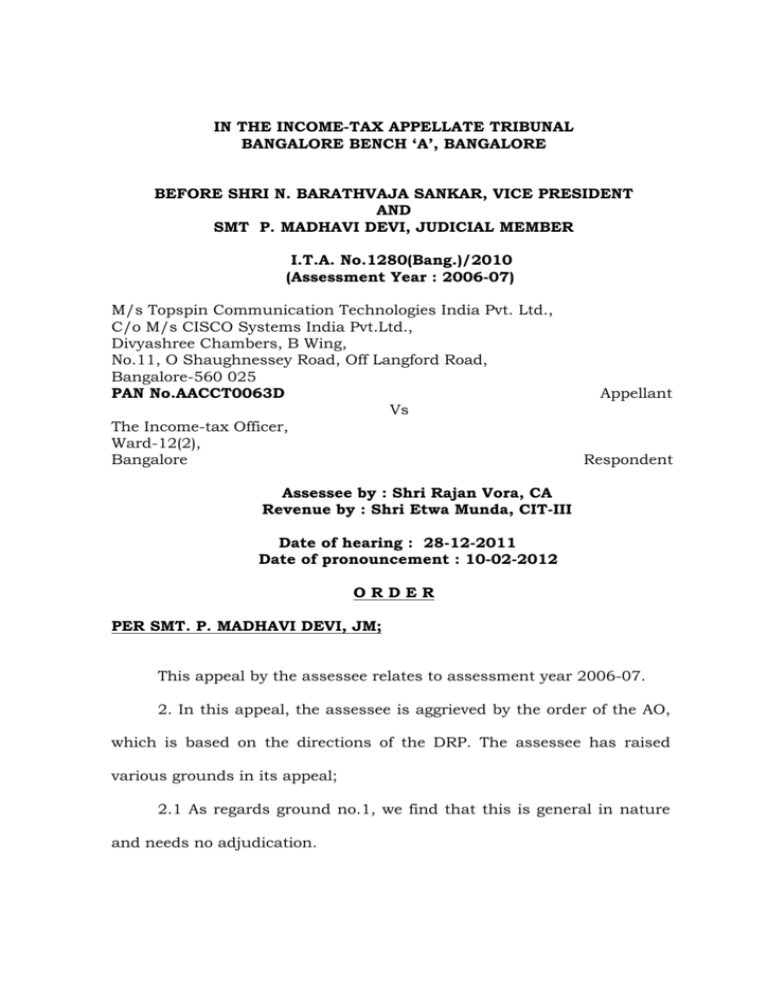
IN THE INCOME-TAX APPELLATE TRIBUNAL BANGALORE BENCH ‘A’, BANGALORE BEFORE SHRI N. BARATHVAJA SANKAR, VICE PRESIDENT AND SMT P. MADHAVI DEVI, JUDICIAL MEMBER I.T.A. No.1280(Bang.)/2010 (Assessment Year : 2006-07) M/s Topspin Communication Technologies India Pvt. Ltd., C/o M/s CISCO Systems India Pvt.Ltd., Divyashree Chambers, B Wing, No.11, O Shaughnessey Road, Off Langford Road, Bangalore-560 025 PAN No.AACCT0063D Vs The Income-tax Officer, Ward-12(2), Bangalore Appellant Respondent Assessee by : Shri Rajan Vora, CA Revenue by : Shri Etwa Munda, CIT-III Date of hearing : 28-12-2011 Date of pronouncement : 10-02-2012 ORDER PER SMT. P. MADHAVI DEVI, JM; This appeal by the assessee relates to assessment year 2006-07. 2. In this appeal, the assessee is aggrieved by the order of the AO, which is based on the directions of the DRP. The assessee has raised various grounds in its appeal; 2.1 As regards ground no.1, we find that this is general in nature and needs no adjudication. 2 ITA No.1280(B)2010 3. As regards ground nos.2 & 3, we find that these issues are covered in favour of assessee by the decision of the Hon’ble jurisdictional High Court of Karnataka in the case of CIT Vs Tata Elxsi Ltd & Others (In ITA No.70 of 2009) wherein it has been held that where certain expenditure is excluded from the export turnover, then the same should have been reduced from the total turnover also for the purpose of computing the deduction u/s 10A of the IT Act. These grounds are accordingly, disposed of with similar directions to the AO. 4. As regards ground no.4, the brief facts of the case are that during the relevant assessment year, the assessee had not received export turnover of Rs.7,51,18,957/- by September 30, 2006. Out of this, a sum of Rs.7,35,21,599/- was realized in the year 2009 and the balance amount was not realizable. The assessee had not got any specific approval from the RBI for the delayed realization of export proceeds. The AO taking note of the above fact that the assessee has not obtained approval of the RBI for receipt of the export proceeds, disallowed the same. Aggrieved, the assessee preferred an appeal before the CIT(A) who confirmed the order of AO. The assessee is in second appeal before us. 5. The learned counsel for the assessee, Shri Rajan Vora, submitted that subsequent to the receipt of the export turnover, belatedly, an application was made to the RBI for technical compliance of tax provisions, explaining the reasons for the delay and specific approval was sought from the RBI for regularization of delay in realization. It was ITA No.1280(B)2010 3 submitted that once an application is made to the authorized dealer (Bank) or RBI for condonation of delay in receipt of foreign exchange and later on if the foreign exchange is received by the Bank without any complaint then it is sufficient compliance of the provisions of Sec.10A of the IT Act r.w..s.155(11A) of the IT Act, as decided by the Tribunal in the case of M/s Diksha No.1064/BNG/2010. Technologies Pvt.Ltd., Vs DCIT (ITA It was submitted that in the case before us, the RBI has specifically condoned the delay in respect of foreign exchange vide its letter dated 21-09-2011 which is placed at page no.399 of the paper book no.2. Thus, according to him the RBI had specifically condoned the delay in receipt of foreign exchange and therefore, it is sufficient compliance of Sec.155(11A) of the IT Act. 5.1 The learned DR however, supported the order of the authorities below and submitted that the approval of RBI is subsequent to the order of the DRP which is September, 2006 and therefore, the approval of the RBI is to be verified by the AO. 6. Having heard both the parties and having considered the rival contentions, we find that the assessee has obtained the approval of the RBI, post realization of the export turnover and the lower authorities have not had an occasion to verify the genuineness of the same, In view of the same, we are inclined to remit this issue to the file of the assessing authority with a direction to take into consideration, the approval of the RBI dated 31-05-2011 and if it is found to be in order, then the assessee 4 ITA No.1280(B)2010 shall be granted deduction u/s 10B of the IT Act on the balance permitted to be realized after 30-09-2006. This ground is accordingly allowed for statistical purposes. 6.1 As regards ground nos.5 to 14 are considered, we find that these grounds relate to the transfer pricing adjustments made to the income of the assessee arising out of the transaction of software research and development services rendered by the assessee to its associated enterprises. The assessee is challenging the fresh economic analysis conducted by the TPO for determination of Arms Length Price (ALP) and using the data relevant to the financial year 2005-06 only which is not available to the assessee at the time of complying with the TP documents requirements and that the TPO has rejected certain comparables considered by the assessee by applying different quantitative and qualitative filters and have considered certain companies using unreasonable comparability criteria obtained by using the powers u/s 133(6) of the IT Act. He is also aggrieved that the TPO has not considered the foreign exchange gain/losses as part of operating income while computing the adjustment and has not considered the provisions written back as part of the operating income, while computing the margin and not making suitable adjustments on account of differences in the risk profitle of the assessee vis-a-vis the comparables, while conducting comparability anlaysis. 5 ITA No.1280(B)2010 6.2 The assessee is also aggrieved by the order of the AO in not giving standard deduction of + or - 5% adjustment under the proviso to Sec.92C of the IT Act. 7. After hearing both the parties at length, we find that the issues raised in ground nos.5 to 11 ,14 & 15 have also arisen in the case of M/s Genisys Integrating Systems (Ind.) Pvt. Ltd., before the ‘A’ Bench of this Tribunal in ITA No.1231(B)/2010 and this Tribunal and vide order dated 05-08-2011 this Tribunal has answered the questions and also given certain guidelines for completing the TP adjustment. The relevant paragraph i.e. para 7-15 are reproduced hereunder; “ 7. As regards the filters selected by the assessee in making the transfer pricing study, the learned counsel for the assessee submitted that the assessee has adopted a turnover range of Rs.1.00 crore at the lower end and Rs.200 Crores at the higher end while choosing the comparables. He submitted that this adoption of upper limit of Rs.200 Crores is based on the Dun and Bradstreet’s analysis which has classified the software companies into the following categories; 1. Large size firms (Rs.20,000 Mn) 2. Medium size firms (Rs.2,000-20,000 Mn) 3. Small size firms (Rs.2,000 Mn) 7.1 The learned counsel for the assessee submitted that the TPO has rejected the upper limit of Rs.200 Crores on the ground that there is no relationship between sales and margins in the service sector as fixed assets are very ITA No.1280(B)2010 6 minimal. He submitted that this is not correct because, the size of the comparable is an important factor of comparability and that it is also recognized by the statute, especially the Rules. He submitted that Rule 10B(3) lays down guidelines for comparing an uncontrolled transaction with an international transaction and as per the said Rule difference for transfer pricing purposes can be of two types; 1. Difference in transactions being compared or 2. Difference in enterprises 8. According to learned counsel for the assessee size is an important facet of an enterprise level difference. He submitted that comparables should have something similar or equivalent and should possesses same or almost the same characteristics. To use a simile, he submitted that a Maruti 800 Car cannot be compared to Benz Car, even though both are cars only. He submitted that unusual pattern, stray cases, wide disparities have to be eliminated as they don’t satisfy the test of comparability. Companies operating on large scale benefit from economies of scale, higher risk taking capabilities, robust delivery and business models as opposed to the smaller or medium sized companies and therefore, size matters. Two companies of dis-similar size therefore, cannot be assumed to earn comparable margins and this impact of difference in size could be removed by an quantitative adjustment to the margins or price being compared if it is possible to do so reasonably accurately. He submitted that size as one of the selection criteria has 7 ITA No.1280(B)2010 also been approved by various benches of the Income-tax Appellate Tribunal, in the following cases; 1. DCIT Vs Quark Systems Pvt.Ltd., 38 SOT 307 (SB), wherein it was held that even the filter of lower turnover of Rs.1.00 crore is without any reasonable basis and there is no filter for higher turnover also. The application of turnover filter also leaves much to be desired and has to no rationale basis. In our considered view, it is improper to proceed on the basis that the turnover of Rs.1.00 core to infinite is a reasonable classification as turnover base. 2. M/s Egain Communications Pvt. Ltd., Vs ITO 118 TTJ 354.(ITAT,Pune) 3. M/s Sony India (P)Ltd., Vs DCIT 114 ITD448 (ITAT Delhi) 4.DCIT Vs Indo American Jewellery Ltd.,ITA No.6194(ITAT, Mum.) 5.M/s Philips Software Centre Pvt.Ltd.,26 SOT 226 6. ACIT Vs NIT 10 Taxman.com 42 8.1 He further submitted that size as a criteria for selection of comparables is also recommended by OCED in its TP guidelines. The observation of OCED in para-3.43 of the Chapter on guidelines reads as follows; “ Size criteria in terms of sales, assets or number of employees: The size of the transaction in absolute value or in proportion to the activities of the parties might affect the relative competitive positions of the buyer and seller and therefore comparability”. 8.2 The learned counsel for the assessee submitted that similar observations were also made by ICAI in para15.4 ITA No.1280(B)2010 8 of TP guidance Note. He submitted that TPO’s range of Rs.1.00 crore to infinity has resulted in selection of companies like M/s Infosys which is having a turnover of Rs.9,028 cores which is 1,1007 times bigger than the assessee company crores. which has a turnover of Rs.8.15 He further submitted that NASSOM was also categorized the companies based on the turnover as follows; 1. Greater than USD 1 Billion (approximately 5,0000 crores) 2. Between USD 100 Million to USD 1 Billion(Rs.500 crores to Rs.5,000 crores) and 3. Others having less than USD 100 Million (Rs.500 croes) Thus, the learned counsel for the assessee submitted that an appropriate turnover range should be applied in selecting a comparable of uncontrolled companies and the assessee has accordingly, applied the turnover range of Rs.1.00 crore Bradstreet’s to 200 analysis. crores He based submitted on Dun that in and the alternative, the categories recognized by1 NASSCOM may also be applied in selecting comparables. 8.3 The learned DR rebutted this argument and submitted that the Act or Rules do not provide for the turnover filter. He submitted that as rightly pointed out by the TPO in the case of service sector, the size of the company does not matter because, the infrastructure layout is very less and it will not affect the profit ratio in any way. He drew our attention to the particular portion of TPO’s order wherein 9 ITA No.1280(B)2010 the TPO has the reasoning given for rejecting the turnover filter. 9. Having heard both the parties and having considered the rival contentions and also the judicial precedents on the issue, we find that the TPO himself has rejected the companies which are making losses as comparables. This shows that there is a limit for the lower end for identifying the comparables. In such a situation, we are unable to understand as to why there should not be an upper limit also. What should be upper limit is another factor to be considered. We agree with the contention of the learned counsel for the assessee that the size matters in business. A big company would be in a position to bargain the price and also attract more customers. It would also have a broad base of skilled employees who are able to give better output. A small company may not have these benefits and therefore, the turnover also would come down reducing profit margin. Thus, as held by the various benches of the Tribunal, when companies which are loss making are excluded from comparables, then the super profit making companies should also be excluded. For the purpose of classification of companies on the basis of net sales or turnover, we find that a reasonable classification has to be made. Dun & Bradstreet and NASSCOM have given different ranges. Taking the Indian scenario into consideration, we feel that the classification made by Dun & Bradstreet is more suitable and reasonable. In view of the same, we hold that the turnover filter is very important and the companies having a turnover of Rs.1.00 core to 200 crores have to be taken as a particular range and the assessee being in that range having turnover of 8.15 10 ITA No.1280(B)2010 crores, the companies which also have turnover of 1.00 to 200.00 crores only should be taken into consideration for the purpose of making TP study. 10. The next issue raised by the learned counsel for the assessee is that while making the comparability analysis, the TPO conducted enquiries from certain companies by exercising powers conferred on him u/s 133(6) of the Act and these notices and the replies have been provided to the assessee. He submitted that the TPO has issued notices to 154 companies, but why these companies were selected is not clear. He submitted that the information had been provided to the assessee in the form of CD but it is not clear as to whether all the responses have been incorporated in the CD given to the assessee. He submitted that the entire process lacks transparency and fairness because six companies which have been finally taken by the TPO do not find place in the initial list of companies generated by the learned TPO. He submitted that the TPO selected Megasoft Ltd., as comparable and as seen from the details provided to the assessee alongwith the initial show cause notice, he rejected companies which fail in RPT and employee cost filters but M/s Megasoft Ltd., which fails RPT filter and employee cost filter was also considered and the TPO has issued a notice u/s 133(6) of the IT Act to M/s Megasoft Ltd., which clearly shows the arbitrary approach of the TPO. He submitted that the assessee has raised this issue before the DRP also, but the DRP only stated that not providing complete information received from the companies in response to notice u/s 133(6) is intentional, as the data and information is voluminous and therefore, only ITA No.1280(B)2010 11 relevant information is given. Thus, according to him withholding of such information results in prejudice to the assessee and is against the principles of natural justice. He further submitted that Rule 10D provides that information specified in sub-rule(1) shall be supported by authentic documents., but the TPO has not established whether the information obtained by way of notice u/s 133(6) is authentic and complete. He drew our attention to page-341 of PB-1 to demonstrate various differences between the annual reports of the comparables and the replies received to notices u/s 133(6) of the IT Act. He submitted that inspite of all the differences, the TPO has completed the assessment by relying upon replies received to notices u/s 133(6), in preference to the annual reports of the professionally companies qualified which Chartered are certified Accountants by and approved by the Board of Directors. 10.1 The learned counsel for the assessee also submitted that the TPO has relied on segmental information received u/s 133(6) which otherwise does not form part of annual report. The bifurcation and reporting of income and expense into different segments is done by the company and is not audited by a Chartered Accountant and it is possible that the same may not be as per accounting standard-17 issued by the ICAI and hence, either the information is incomplete or unreliable apart from being unverifiable. To demonstrate this point, the learned counsel for the assessee submitted that M/s Sankhya Infotech was selected as comparable in the preceding assessment year 2005-06 on the ground that it is a software development company on the basis of reply 12 ITA No.1280(B)2010 received to notice u/s133(6) inspite of the objection of the assessee that this company is a software product company. But during the year under consideration, the same company has been rejected on the ground that it is a software product company which is again based on reply received to notice u/s 133(6) of the IT Act. Thus, the learned counsel for the assessee submitted that these inconsistencies in the process of TPO raises doubts regarding transparency and genuineness of the entire process. Another point advanced by the learned counsel for the assessee is that the information obtained by the TPO by issuing notices u/s 133(6) is not available in public domain at the time of study by the assessee. He submitted that Rule-10D prescribes the documents to be kept and maintained u/s 92D and sub-rule (4) thereof deals with the process and the method to be adopted in making the comparability analysis. He submitted that as per this sub-rule, the information and documents should as far as possible be contemporaneous and should exist latest by the specified date referred to in clause(iv) of sec.92F. According to him, the dictionary meaning of contemporaneous is ‘existing or occurring at the same time, of the same historical or geographical period’. 10. 2 As per Rule 10D, the information and documents prescribed there in must be kept and maintained by the assessee latest by the prescribed date i.e for AY: 2006-07 by 31st October, 2006 and accordingly the assessee has kept and maintained the information and documents. The TPO is collecting, collating and compiling data two/three years after the date of the assessee’s documentation, ITA No.1280(B)2010 13 ignoring the fact that in choosing the most appropriate method, availability of data is a relevant factor, under /rule10C(2)(c) of the Act. He thus, submitted that the power of the TPO cannot be used to cover information that comes into public domain after the specified date. He submitted that the existence of the specified date is very important because what was correct and complete on the basis of data existing by a specified date would become unreliable or incomplete in the light of the data that comes into existence subsequently. He submitted that if subsequent information is permitted to be used, then the ALP would remain fluid before the TPO, DRP, CIT(A) and the ITAT and the higher forums and this can lead to ever changing ALP. He submitted that the ALP is not dynamic or fluid subject to vagaries of future date. He submitted that the TP analysis is an art and not a science and mathematical precision are not desired nor expected. When the assessee has placed his entire process before the learned TPO and there is no allegation that it was short of or that the material facts have been dodged or that it was incomplete, the same cannot be brushed aside. He thus, prayed that the data available subsequently or obtained through notice u/s 133(6) should be rejected. 11. The learned DR on the other hand, supported the orders of the authorities below and submitted that deals with the manner in which the ALP is to be determined u/s 92C of the Act and sub-rule(4) thereof. Sec.10B provides that the data to be used in analyzing the comparability of an uncontrolled transaction with an international transaction shall be the data relating to the financial year in which the international transaction has been entered ITA No.1280(B)2010 14 into. Thus, he submitted that not only the comparables adopted by the assessee but information relating to other companies which are available in the public domain at the time of determining the ALP also have to be considered by the TPO, while making the TP adjustments. He submitted that the act or Rules do not specify the date, till which only the information available in the public domain can be utilized. He submitted that though sec.92D and Rule-10D prescribes the information and documents to be kept and maintained u/s 92D of the IT Act, it is not prohibited nor is it specified therein that only the documents maintained by the assessee have to be taken into consideration. He submitted that the TPO is under an obligation to verify the information and documents kept and maintained by the assessee and wherever he feels that some more information is necessary for making the TP adjustment, he may also make his own search and use the relevant years data available in the public domain. Thus, in view of this power of TPO, the TPO has made the search of the databases and has issued notices to the relevant parties u/s133(6) of the Act to gather information which is not available in the public domain. After considering replies to the said notices, the TPO has rejected many companies and has selected only the relevant comparables and all the information which is sought to be used by the TPO for making the TP adjustments has been supplied to the assessee and the assessee was given ample opportunity of making its objections. He submitted that the TPO after considering the assessee’s objections only has made the TP adjustments and therefore, there is no violation of principles of natural justice nor there is any lack of ITA No.1280(B)2010 15 transparency or fairness. Thus, according to him, the TPO has been reasonable in following the procedure laid down by the Act and there is no infirmity in the order of the TPO which has been approved by the DRP. 12. Having heard both the parties and having considered the material on record, we find that the following questions arise for our consideration on this issue; 1. What is the data to be considered by the TPO at the time of determining ALP ? 2. Whether the assessee should be given an opportunity to rebut the material sought to be used by the TPO ? 12.1 As far as the data to be used by the TPO while determining the ALP is concerned, we find that it is covered by the provisions of Rule -10D sub-rule-4 of the IT Rules, 1962. Sec.92C provides the method for computation of ALP and prescribes five methods for computing the ALP and also any other method as may be prescribed by the Board. Sec.92D provides that every person who has entered into an international transaction shall maintain and keep such information and documents in respect thereof and the Board may also prescribe the period for which the information and documents shall be kept and maintained and the AO and the CIT(A) may in the course of any proceedings under the Act, require any person who has entered into an international transaction to furnish any information and documents in respect thereof. Thus, it can be seen that the requirements is only to maintain and keep the information and documents relating to international transactions so that they are available as and when required during any proceedings under the Act. The section does not provides that the ITA No.1280(B)2010 16 information and documents are to be kept and maintained for a period of 8 years. Rule 10-D of sub-sec.1 specifies the documents and information which are to be kept and maintained by the assessee and sub-rule-2 thereof provides that nothing contained in sub-rule-1 shall apply in a case where the aggregate value as recorded in the books of accounts, the international transactions entered into by the assessee does not exceed 1.00 crore rupees. Sub-rule-3 provides the supporting authentic documents which are to be kept and maintained and sub-rule-4 thereof provides that the information and documents specified under sub-rule 1 & 2 should as far as possible be contemporaneous and should exists latest by the “specified date” referred to in clause-4 of 92F. Clause-4 of sec.92F gives the definition of “specified date” to have the same meaning as assigned to ‘due date’ in Explanation-2 below sub-sec.1 of sec.139. Explanation-2 to sec.139 defines ‘due date’ in a case of a company to be ‘30th day of September of the assessment year’. The assessee before us is a company and therefore, as on ‘30th day of September’ of the relevant assessment year, the assessee is supposed to maintain information and documents. After going through the above provisions of law, it is clear that the Act has not provided for any cut off date upto which only the information available in public domain has to be taken into consideration by the TPO, while making the TP adjustments and arriving at arm’s length price. The assessee as well as the revenue are both bound by the Act and the Rules there under and therefore, as provided under the Act and Rules they are supposed to be taking into consideration, the 17 ITA No.1280(B)2010 contemporaneous data relevant to the previous year in which the transaction has taken place. The assessee had strenuously argued that the provision of sec.92D and Rule-10D is defeated if, the TPO takes the data which is available in the public domain after the specified date and the ALP would be fluid and there would be no certainty for the same. We are unable to agree with the arguments of the learned counsel for the assessee. The ALP has to be determined by the TPO in accordance with law and the Act provides that the TPO shall take into consideration the contemporaneous data. The assessee is only required to maintain the information and documents as may be necessary relating to the international transactions so that it can be made available to the TPO or the AO or any other authority in any proceedings under the Act. By providing a specified date in the Act, the obligation is cast upon the assessee to keep and maintain the documents for that period. But, it does not restrict the TPO from making enquiries thereafter, for determining the correct ALP. Having held so, we come to the next question, as to whether the TPO can make his own research and call for information from various entities without the knowledge of the assessee. Under sub-sec(3) & (7) of sec.92CA, the TPO is entrusted with all the powers under clauses (a) to (d) of sub-sec.1) of sec.(3) or sub-sec.(6) of sec.133 to call for and gather any information as may be required. When he is making the search for a relevant comparable, the TPO can issue notices to the parties whom he considers as relevant to gather requisite information and on being satisfied with regard to relevancy of the material which can be used against the assessee only then the assessee ITA No.1280(B)2010 18 has to be given an opportunity of presenting its objections. Thus, the TPO need not inform the assessee about the process used by him for issuing the notices u/s 133(6) nor is he under any obligation to furnish the entire information to the assessee. The principles of natural justice requires that when any information is sought to be used against the assessee, the assessee shall be given a fair opportunity of hearing on that material. In the case before us the TPO has furnished all the information to the assessee in the form of CD and the assessee after going into the same has submitted a detailed submission along with its objections for taking various companies as comparables. It is another matter, if the TPO has not considered the objections of the assessee judiciously. In such a case, it would be an error of judgment and not violation of principles of natural justice. The objections of the assessee is that certain companies have been taken into consideration by the TPO as comparables without giving the assessee an opportunity of presenting its objections and also with regard to certain other companies, it had sought opportunity to cross examine them, but the said opportunity was not given. 13. We have already held that if any information is sought to be used against the assessee, the same has to be furnished to the assessee and thereafter, taking into consideration the assessee’s objections, if any, only then can the TPO proceed to take a decision. If the assessee seeks an opportunity to cross examine the party, the assessee shall be provided such an opportunity. It is only during a cross examination that the assessee can rebut the stand of that particular company. The assessee has ITA No.1280(B)2010 19 also brought out various defects in the additional comparables selected by the TPO and has brought out the glaring differences between the functions of those comparables as compared to assessee and also as to how the entire revenue of the assessee has been taken into consideration inspite of there being income from unrelated party transactions also. All these objections have been given in detail in the written submissions. We find that the TPO has not considered these objections, while determining the ALP. Further, the learned counsel for the assessee has also submitted that the assessee should be given a standard deduction of 5% as provided under the proviso to sec.92C(2) before making adjustments for the transfer price. In support of his contention, he placed reliance on the following decisions: 1.M/s Sap Labs India Pvt.Ltd., Vs ACIT 2010-TII-44 ITAT-BANG-TP 2.Philips Software Centre Pvt.Ltd., 26 SOT 226 3. MSS India Pvt.Ltd., 32 SOT 132 4. Customer Services India Pvt.Ltd., Vs ACIT 30 SOT 486 5. Skoda Auto India Pvt.Ltd., Vs ACIT 2009-TIOL-214-ITAT-PUNE 6. Development Consultants Pvt.Ltd., Vs DCIT 23 SOT 455 7. Sony India Pvt.Ltd., 315 ITR 150 8. Cumins India Ltd., Vs DCIT ITA NO.277 & 1412/PN/07 9. TNT India Pvt.Ltd., Vs ACIT 10 Taxman.com 161 10. Abhishek Auto Industries Ltd Vs DCIT 2010-TII-54-ITAT-DEL-TP 13.1 The learned DR however, relied on the orders of the authorities and submitted that 5% is not the standard deduction, but it is the range within which if the ALP falls then the ALP of the assessee has to be accepted. 13.2 Having heard both the parties and having considered their rival contention, we find that this issue is 20 ITA No.1280(B)2010 already covered by the decision relied upon by the assessee. 13.3 In view of the same, we deem it fit and proper to remand the issue to the file of TPO with the following directions; a) The operating revenue and the operating cost of the transactions relating to associated enterprises only shall be considered; b) The comparables having the turnover of morethan 1.00 crore but less than 200.00 crores only shall be taken into consideration; c) All the information relating to comparables which are sought to be used against the assessee shall be furnished to the assessee; d) The assessee shall be given an opportunity of cross examining the parties whose replies are sought to be used against the assessee if the assessee so desires; e) To consider the objections of the assessee that relate to additional comparables sought to be adopted by the TPO and pass a detailed order and f) To give the standard deduction of 5% under the proviso to sec.92C(2) of the Act. 14. Similarly, in the ITES segment also the assessee has raised various grounds i.e. adoption of various companies as comparables and additional filters used by the TPO. For the detailed reasoning given by us for the above software development service segment, we direct the TPO to consider the assessee’s objections and compute the ALP, after giving the assessee an opportunity of hearing after observing our directions given above. ITA No.1280(B)2010 21 15. With regard to low capacity utilization, adjustments to be given in the determination of ALP in ITES sector, the learned counsel for the assessee submitted that during the year under consideration the assessee had under utilized its facilities to the extent of 51.89% and therefore, this adjustments also should be given while determining the ALP. After giving adjustments, according to him the net operating margin on cost would be 27.46%. He submitted the that the learned TPO has rejected adjustments on the ground that comparables have similar problem as they have idle bench strength. He submitted that the adjustments sought was for under utilization of infrastructure while in the case of comparables, it is the case of idle bench strength. He submitted that infrastructure certain fixed costs attached to it which would affect the operating margin of the assessee considerably”. In view of the same, we set aside the order of the assessing authority and direct AO to complete the TP analysis afresh in accordance with law and the guidelines in the above case. Needless to mention that the assessee should be given a fair opportunity of hearing. Thus, these grounds are accordingly disposed of for statistical purposes. 9. Coming to ground no.12, the learned counsel for the assessee submitted that the TPO has excluded the foreign exchange (income/expenses) and provisions written back while computing the 22 ITA No.1280(B)2010 operating margin on the ground that these are non-operating in nature. He submitted that the foreign exchange fluctuation gain or loss and provision written back are closely linked to the business operations of the assessee and do not constitute abnormal/extraordinary items and therefore, should be considered as operating income/expenditure. In support of his contentions, learned counsel for the assessee relied upon the following case laws; 1. M/s SAP Labs India Pvt.Ltd.,Vs ACIT, B”lore(44 SOT 156(B’lore). 2. CIT Vs Gem Plus Jewellery India Ltd., (2011) 330 ITR 175 3. M/s Sony India Ltd., Vs DCIT (114 ITD (Del.) 448. The learned DR on the other hand, placed reliance upon the orders of the authorities below. 10. Having heard both the parties and having considered the rival contentions, we find that the authorities below have not considered the judicial precedents on the issue while excluding these items while computing the operating margin. In view of the same, we deem it fit and proper to remit these issues also to the file of the assessing authority for re-consideration of the matter in the light of the judicial precedents on the issue and in accordance with law. allowed for statistical purposes. These grounds are also thus, ITA No.1280(B)2010 23 11. Ground no.16 is consequential in nature and ground no.17 is premature. In view of the same, ground no.16 is allowed for statistical purposes and ground no.17 is dismissed. 12. In the result, the appeal filed by the assessee is partly allowed for statistical purposes. Order pronounced in the open court on the 10th February, 2012. Sd/(N.BARATHVAJA SANKAR) VICE PRESIDENT Place: Bangalore Dated: 10-02-2012 am* Copy to : 1. The Assessee 2. The Revenue 3. CIT(A) 4. CIT 5. DR 6. GF(B’lore) Sd/(SMT. P. MADHAVI DEVI) JUDICIAL MEMBER By Order AR, ITAT, BANGALORE
